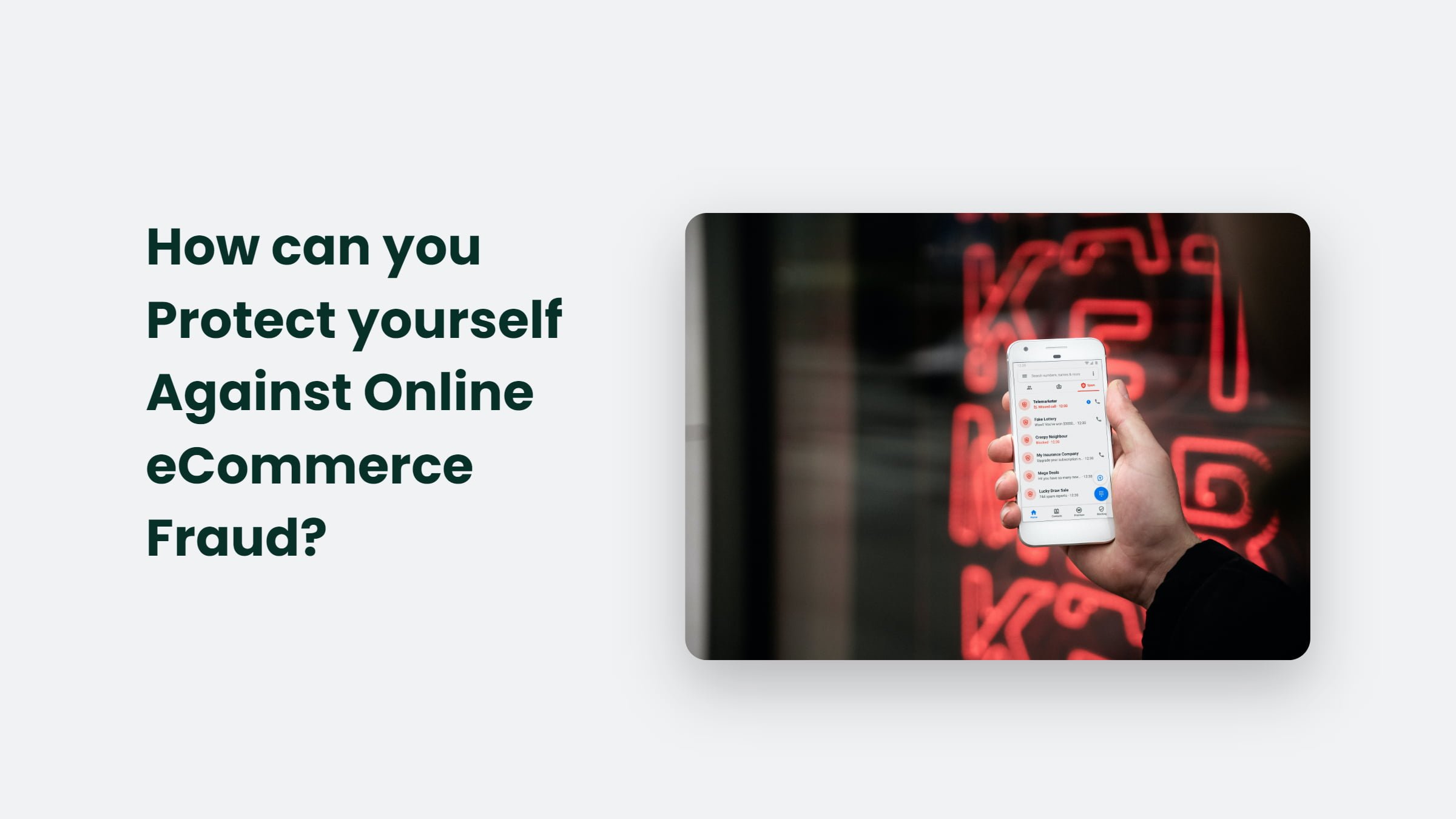

How can you Protect yourself Against Online eCommerce Fraud in 2023

As Seen On
With the rise in digital transformation, eCommerce has taken off and become a global phenomenon that merchants around the world utilize.
However, as more transactions occur online, there is an increased risk of fraud – something to be aware of if you are an online consumer.
This blog will advise how to protect yourself against fraudulent activity when engaging in eCommerce so that your personal information remains secure and your credit card payments remain safe.

What is eCommerce fraud?
eCommerce fraud is an unfortunate reality for many online retailers—today, who are often unaware that their customers may be engaging in fraudulent activities.
The most common type of eCommerce fraud involves using stolen credit cards or counterfeit payment information, where scammers place orders with retailers and then cancel them after receiving the goods.
Customers can also falsify their addresses when ordering, making it difficult for eCommerce stores to ensure they’re not shipping items to criminals.
Businesses must be responsible for verifying each customer’s identity and using secure payment portals to protect themselves against eCommerce fraud.
Ultimately, educating customers and ensuring they understand online fraud’s repercussions will help minimize its incidence.
Two Types of Online Store Fraud:
Online shopping is becoming increasingly popular due to its convenience, but it can also open the door to fraudulent activities.
There are two major types of fraud shoppers must be aware of when using online stores.
Phishing Scams:
The first type is known as phishing scams. This type involves criminals sending stolen information, such as credit card details and personal bank account numbers, in the guise of legitimate companies or organizations.
Skimming Scams:
The second type, called skimming scams, is more common. It occurs when criminals place electronic devices on ATMs or other payment gateways to steal customer information, such as their credit card numbers, when they make a purchase.
As a consumer, taking all necessary precautions when shopping online is essential to protect yourself from these dangerous fraudsters.
How do I manage my risk?

If you are using an online store, there are a few steps you should take to manage your risk of becoming the victim of fraud.
Firstly, ensure that any website you shop on is secure and uses encryption technology when storing or transferring customer data.
You should also never give out personal information over the phone or via email, and be sure to use a secure payment method such as PayPal or a credit card with fraud protection.
Finally, always stay alert when shopping online – if an offer looks too good to be true, it probably is!
Being aware of the risks and taking steps to protect yourself is the best way to ensure that you remain safe while shopping online.
By following these steps and educating yourself on eCommerce fraud, you can shop confidently, knowing that your data is secure and your transactions are protected.
How can you Protect yourself Against Online eCommerce Fraud:
Use a service to cover fraud-based chargebacks:
One of the best solutions for protecting against fraud-based chargebacks is to use a service that helps to cover them.
Typically, these services are offered as an add-on from payment processors or third-party companies and provide safety nets that protect eCommerce companies in case of fraud.
By implementing one of these services, businesses will have financial protection from fraudulent activity while limiting the need to investigate every transaction manually. It can decrease costs significantly and help protect online businesses from potentially severe financial losses.
Set up workflows to handle fraud seamlessly
To prevent fraud, businesses must stay ahead of the curve regarding security measures.
Implementing eCommerce fraud prevention methods, such as automated workflows, can help streamline the process.
Through these workflows, businesses can set up parameters for detecting fraudulent charges allowing them to identify and address suspicious transactions quickly and efficiently.
Businesses should also create well-defined customer service guidelines to promptly respond to customers who may have experienced fraud on their accounts or payments.
By setting up these automated workflows and customer services guidelines, businesses will be better positioned to protect themselves from fraud while also creating an improved customer experience.
Double down on security during peak shopping seasons
During the holiday months, multitudes of shoppers flock online to search for and purchase their gifts.
As eCommerce merchants, this is an excellent season to increase sales, but it can also be a great opportunity to become the victim of fraud.
The best action to protect against fraudulent purchases is to double down on security measures throughout peak shopping seasons.
It includes verifying suspicious orders, implementing multi-factor authentication for customers, setting up extensive monitoring of accounts, and actively responding to alerts.
Merchants should also be sure to review orders from unfamiliar locations or addresses thoroughly and require additional proof of identity during high-risk transactions.
Protecting against eCommerce fraud is never foolproof, but taking these precautions will give your customers added peace of mind when shopping with you.
Leverage Shopify’s fraud detection and analysis tools
Shopify has created tools to help identify and prevent fraud, which provides peace of mind for customers and merchants alike.
With advanced analytics, Shopify can detect suspicious activities, including account takeover attempts and card-testing fraud.
The system will then provide an automated assessment score that is invaluable in helping merchants decide whether a transaction should be approved or not. Furthermore, Shopify also offers manual reviews to give merchants even more control over who they do business with.
Through professional review services, highly qualified experts help determine if transactions are legitimate or fraudulent. By taking advantage of these methods available through Shopify, businesses can protect their customers and products from potentially fraudulent transactions.
Ensure PCI-compliance
To ensure that customers’ data and transaction information stay safe and secure, entities must establish PCI compliance across their websites and other systems.
Furthermore, establishing comprehensive fraud prevention measures is essential to guarantee safe payment processing.
These preventive tactics include verifying email addresses and asking for additional data, implementing third-party risk inhibitors, using machine learning to detect red flags in a customer’s ordering process, or requiring secure passwords or two-factor authentication for logging into accounts.
With the right strategies, eCommerce entities can protect their customers against payment fraud.
Consider setting limits
One of the measures businesses can take is setting purchase limits for customer accounts, so that suspicious transactions can be quickly flagged.
Aside from this, businesses should also be diligent in regularly reviewing recent orders and checking for suspicious activities like multiple orders from unknown locations or addresses sent to one customer account.
Moreover, creating a secure checkout process by ensuring data encryption and using two-factor authentication to verify customer identity can help reduce the chances of fraudulent purchases.
Taking these proactive steps will help protect your business and customers against potential eCommerce fraud in the future.
Encrypt your website with SSL
SSL stands for Secure Socket Layer and uses encryption algorithms to encrypt any sensitive information passed from a customer’s browser, like passwords and credit card numbers, to the web server.
SSL also ensures that data is not intercepted and decoded by a third party in transit; it is essential for securing any shared information between a merchant and its customers.
All legitimate eCommerce websites should display “HTTPS” in their address bar, which shows that the connection has been secured with an SSL certificate.
This extra layer of security provides customers peace of mind that their data will be kept secure during a transaction.
Conduct manual checks on suspicious purchases
Manual checks on suspicious purchases ensure that there is valid payment information and verify with customers when circumstances seem questionable.
This extra step deters fraud attacks and lets customers know that their data is safeguarded. Other fraud prevention methods include strict payment processing policies, elaborate risk management systems, and advanced anti-fraud technologies to detect patterns that could indicate fraudulent activity.
Frequently Asked Questions
How do you protect yourself from being scammed online?
The best way to protect yourself from being scammed online is to be aware of the potential scams you could encounter. Be wary of unsolicited emails, suspicious links, or offers that seem too good to be true. Additionally, ensure that any website you use is legitimate by checking for an SSL certificate and double-checking the URL. Finally, make sure to use secure payment methods like credit cards or PayPal for online purchases.
What is two-factor authentication?
Two-factor authentication (2FA) is a security measure that requires an additional verification step, such as entering a PIN code sent to your phone after entering an initial login credential. 2FA provides an extra layer of security that can help protect your accounts from being compromised by hackers.
What is payment fraud?
Payment fraud is any attempt to make an unauthorized transaction or gain access to sensitive information. This fraud can take many forms, including stolen credit cards, identity theft, phishing scams, etc. Businesses need to be aware of the potential for these types of fraud and take steps to protect their customers.
The Bottom Line:
Fraudulent purchases are a real threat to eCommerce businesses, but with the right approach and measures, you can protect your business and customers from potential risks. Be sure to set purchase limits for customer accounts, use two-factor authentication to verify customer identity, conduct manual checks on suspicious purchases, and encrypt your website with SSL. With a combination of these strategies, you can help ensure that your customers are safe and secure when making online purchases.
Konger
Up until working with Casey, we had only had poor to mediocre experiences outsourcing work to agencies. Casey & the team at CJ&CO are the exception to the rule.
Communication was beyond great, his understanding of our vision was phenomenal, and instead of needing babysitting like the other agencies we worked with, he was not only completely dependable but also gave us sound suggestions on how to get better results, at the risk of us not needing him for the initial job we requested (absolute gem).
This has truly been the first time we worked with someone outside of our business that quickly grasped our vision, and that I could completely forget about and would still deliver above expectations.
I honestly can't wait to work in many more projects together!
Disclaimer
*The information this blog provides is for general informational purposes only and is not intended as financial or professional advice. The information may not reflect current developments and may be changed or updated without notice. Any opinions expressed on this blog are the author’s own and do not necessarily reflect the views of the author’s employer or any other organization. You should not act or rely on any information contained in this blog without first seeking the advice of a professional. No representation or warranty, express or implied, is made as to the accuracy or completeness of the information contained in this blog. The author and affiliated parties assume no liability for any errors or omissions.

